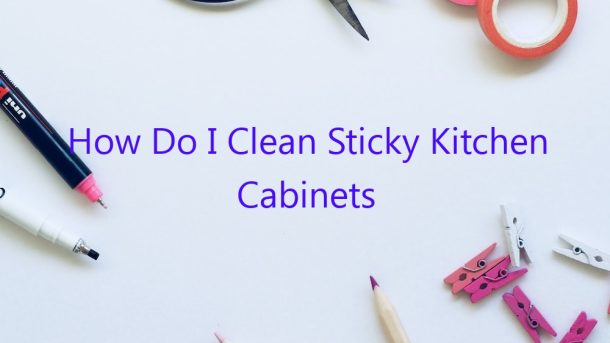Cleaning sticky kitchen cabinets can be a daunting task. However, with the right tools and techniques, it can be a relatively easy process.
The first step is to gather the necessary supplies. You will need hot water, a dish detergent, a sponge, a scrub brush, and a cleaning agent such as vinegar or lemon juice.
The next step is to remove all of the contents from the cabinets. This will allow you to clean the cabinets more effectively.
Then, fill a bowl with hot water and add a few drops of dish detergent. Soak the sponge in the solution and wipe down the cabinets. Be sure to pay close attention to the areas that are the most dirty or sticky.
If the cabinets are still dirty or sticky, you can use a scrub brush to help loosen the dirt. Be sure to use a gentle motion, so you do not damage the cabinet surfaces.
If the cabinets are still dirty or sticky, you can use a cleaning agent such as vinegar or lemon juice. Apply the agent to a sponge and wipe down the cabinets. Allow the agent to sit for a few minutes before rinsing with hot water.
Finally, dry the cabinets with a clean cloth and put everything back in place.
Contents
How do you clean sticky greasy wood cabinets?
Cleaning sticky greasy wood cabinets can be a challenge. The grease and oil can be difficult to remove, and it can be easy to damage the wood in the process. Here are a few tips on how to clean sticky greasy wood cabinets safely and effectively.
The first step is to identify the source of the grease and oil. Often, this can be traced back to cooking oils or grease. If possible, wipe up any excess grease or oil as soon as it is spotted. Wiping it up as soon as it is noticed will make the cleaning process much easier.
Next, use a degreaser to remove the grease and oil. There are a number of commercial degreasers available, or you can make your own by mixing dish soap and ammonia. Be sure to follow the directions on the degreaser carefully to avoid damaging the wood.
Once the degreaser has been applied, let it sit for a few minutes to break down the grease and oil. Then, use a sponge or rag to wipe it up. Be sure to rinse the sponge or rag frequently to avoid spreading the grease and oil.
Finally, dry the cabinets with a towel or a hair dryer. This will help prevent the grease and oil from attracting dirt and dust.
What is the best degreaser for kitchen cabinets?
When it comes to kitchen cabinets, keeping them clean and grease-free is a must. But with all the cooking and cleaning that goes on in the kitchen, it can be tough to know which degreaser is the best for the job.
There are a lot of degreasers on the market, and they all claim to be the best. So, which one should you choose?
Here is a look at some of the most popular degreasers and their pros and cons:
Baking soda: Baking soda is a natural degreaser that is safe to use on kitchen cabinets. It is also a powerful cleaner that can remove stubborn grease and dirt. However, baking soda can be abrasive, so it may not be suitable for all cabinets.
Ammonia: Ammonia is a powerful degreaser that can quickly remove grease and dirt. However, it is also a harsh chemical that can damage cabinets if used incorrectly.
Dish detergent: Dish detergent is a safe and effective degreaser that can be used on kitchen cabinets. It is gentle enough to not damage cabinets, but it is powerful enough to remove grease and dirt.
All-purpose cleaner: All-purpose cleaner is a versatile degreaser that can be used on a variety of surfaces, including kitchen cabinets. It is safe to use and gentle enough not to damage cabinets. However, it may not be as effective at removing grease and dirt as some of the other degreasers listed.
So, what is the best degreaser for kitchen cabinets?
The best degreaser for kitchen cabinets is ultimately the one that is most effective at removing grease and dirt. However, it is important to choose a degreaser that is safe to use and gentle enough not to damage cabinets.
If you are looking for a safe and effective degreaser, dish detergent is a good option. It is gentle enough to use on kitchen cabinets, but it is powerful enough to remove grease and dirt.
How do you clean kitchen cabinets without removing the finish?
Kitchen cabinets are a key part of any kitchen, and they need to be kept clean and in good condition in order to function properly. One question that many people have is how do you clean kitchen cabinets without removing the finish? There are a few different ways that you can do this, and each has its own benefits and drawbacks.
One way to clean kitchen cabinets without removing the finish is to use a chemical cleaner. There are a number of different chemical cleaners available on the market, and most of them are designed to clean grease and dirt. Be sure to read the instructions on the bottle carefully, and always test the cleaner on a small area of the cabinet first to make sure that it does not damage the finish.
Another way to clean kitchen cabinets without removing the finish is to use a non-abrasive cleaner. There are a number of different non-abrasive cleaners available on the market, and most of them are designed to clean grease and dirt. Be sure to read the instructions on the bottle carefully, and always test the cleaner on a small area of the cabinet first to make sure that it does not damage the finish.
A final way to clean kitchen cabinets without removing the finish is to use a wet cloth. Be sure to use a soft cloth that will not scratch the finish of the cabinet. Be sure to wring out the cloth well before using it, and always test it on a small area of the cabinet first to make sure that it does not damage the finish.
Why are the tops of my cabinets sticky?
If you’ve ever walked into your kitchen and noticed that the top of your cabinets are sticky, you’re not alone. This is a common issue, and there are a few possible explanations.
One possibility is that your cabinets are made of particleboard or another type of composite wood. Over time, this wood can absorb moisture, which can cause it to swell and become sticky.
Another possibility is that your cabinets are coated in a glossy finish. This type of finish can attract dirt and dust, which can then become stuck to the surface.
A final possibility is that your cabinets are not properly sealed. If this is the case, moisture and other contaminants can seep into the wood, causing it to swell and become sticky.
If you’re having trouble figuring out why your cabinets are sticky, it’s best to consult a professional. They can help you identify the cause of the problem and recommend a solution.
Why are my kitchen cabinets sticky after cleaning?
When it comes to cleaning our homes, the kitchen is one of the most important rooms to focus on. After all, it’s the place where we cook food and prepare meals. So, it’s important to make sure that our kitchen is always clean and tidy.
One of the most common problems that people face when cleaning their kitchens is that their kitchen cabinets become sticky after cleaning. This can be really frustrating, especially if you’ve just spent a lot of time and effort cleaning them. So, what’s causing this and how can you fix it?
The most likely cause of sticky kitchen cabinets is that they haven’t been cleaned properly. When dirt, grease and food residue builds up on kitchen cabinets, it can cause them to become sticky. This is because the grease and residue acts as a lubricant, making the cabinets harder to clean.
The best way to prevent your kitchen cabinets from becoming sticky is to clean them regularly. This means cleaning them after every time you use them. This may seem like a lot of work, but it will be worth it in the long run.
If your kitchen cabinets have already become sticky, there are a few things you can do to fix it. The first thing you should do is clean them properly. This means using a degreaser or an all-purpose cleaner to remove all the dirt, grease and food residue.
You may also need to polish the cabinets. This will help to remove any remaining grease or residue and will leave them looking shiny and new.
If you find that your kitchen cabinets are still sticky after cleaning, you may need to apply a sealant. This will help to protect the cabinets from future dirt and grease build-up.
Follow these tips and you will be able to keep your kitchen cabinets clean and free of sticky residue.
Can you use Dawn dish soap on wood cabinets?
Can you use Dawn dish soap on wood cabinets?
Yes, Dawn dish soap can be used on wood cabinets. Dawn dish soap is a degreaser and can be used to clean greasy or oily residue from surfaces. It is also a disinfectant and can be used to clean surfaces that may be contaminated. Dawn dish soap is also a detergent and can be used to remove dirt and grime from surfaces.
How do you remove years of grime from kitchen cabinets?
Removing years of grime and dirt from kitchen cabinets can be a daunting task. However, with the right tools and a little bit of elbow grease, it can be done.
The first step is to remove all of the contents of the cabinets and set them aside. Once the cabinets are empty, you can begin to clean them.
If the cabinets are made of wood, you can use a wood cleaner to clean them. If the cabinets are made of plastic, you can use a cleaner designed for plastic surfaces.
Once the cabinets are clean, you can begin to remove the grime and dirt that has built up over the years. One way to do this is to use a toothbrush or a scrub brush. Be sure to use a gentle circular motion to avoid damaging the surface of the cabinets.
If the grime is stubborn, you can use a little bit of dish soap to help loosen it. Be sure to rinse the cabinets thoroughly afterwards to remove all of the soap.
Once the cabinets are clean, you can replace the contents and enjoy your sparkling kitchen cabinets!




